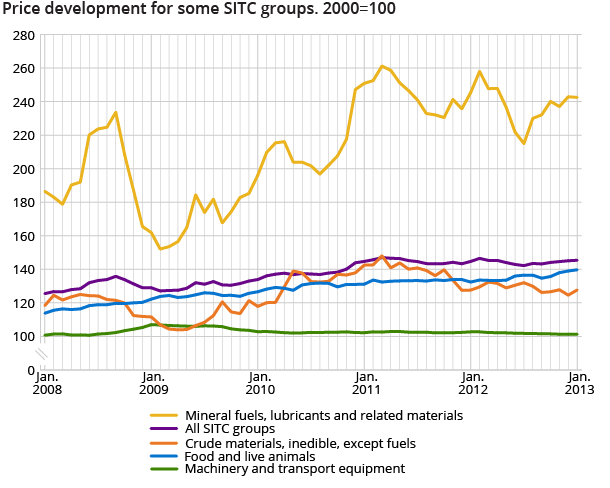Content
Published:
This is an archived release.
Small rise in the PIF
The price index of first-hand domestic sales (PIF) increased by 0.2 per cent from December 2012 to January 2013. Higher prices of metalliferous ores and metal scrap and petroleum and petroleum products contributed to the rise in the overall index.
| Per cent | Per cent | Index | Weights1 | |
|---|---|---|---|---|
| January 2013 / December 2012 | January 2013 / January 2012 | January 2013 | ||
| 1The weights are updated annually, and are valid for the entire year. | ||||
| Product groups | ||||
| Total index | 0.2 | 0.6 | 145.4 | 1 000.0 |
| Food | 0.5 | 5.5 | 139.7 | 177.1 |
| Beverages and tobacco | 1.2 | 5.3 | 145.8 | 14.3 |
| Crude materials, inedible, except fuels | 2.5 | 0.1 | 127.7 | 52.5 |
| Mineral fuels, lubricants and related materials | -0.2 | -1.2 | 242.5 | 231.0 |
| Chemicals and related products, n.e.s. | 0.4 | 2.3 | 143.1 | 71.2 |
| Manufactured goods classified by material | -0.2 | -2.0 | 129.5 | 131.3 |
| Machinery and transport equipment | 0.0 | -1.4 | 101.3 | 231.9 |
| Miscellaneous manufactured articles | 0.1 | 0.1 | 111.3 | 84.6 |
The 0.2 per cent increase in the PIF from December 2012 to January 2013 was mainly due to a 1 per cent rise in prices of petroleum and petroleum products. Within crude materials, inedible, except fuels, higher prices of metalliferous ores and metal scrap was the most important reason for the increase in the PIF. Within food products, higher prices of fish and fish products as well as feeding stuff for animals, with increases of 2.1 and 2.4 per cent respectively, also had a strong influence on the total PIF from December 2012 to January 2013.
A price drop of 2.2 per cent in electricity played an important role in dampening the rise in the PIF. The system price in the Nordic power exchange Nord Pool fell from December to January, while prices of electricity sold to household consumers rose during the same period. Other product groups with falling prices were electrical machinery and apparatus and manufactures of non-ferrous metals. Prices in these groups dropped 0.6 and 1.7 per cent respectively.
Twelve-month rate: prices rose 0.6 per cent
The PIF rose 0.6 per cent from January 2012 to January 2013. Higher prices of electricity as well as chemicals were the most important reasons for the increase in the PIF. Within these two groups, prices rose by 3.7 and 2.3 per cent respectively. Within food products, prices of feeding stuff for animals as well as fish and fish products rose by 16.2 and 7.6 per cent respectively.
An important commodity group that lowered the rise in the PIF from December 2012 to January 2013 was petroleum and petroleum products. Prices within this group fell by 4.6 per cent. Within machinery and transport equipment, lower prices of office machines and data processing machines among other things helped to curb the rise in the total index from January 2012 to January 2013.
Updated weightsOpen and readClose
Going into the new year, the weights used for calculating the price index have been updated. The weights express the influence of different goods on the total price index, and are based on the shares of different goods in the total value of turnover in the Norwegian economy in the previous year.
Compared with 2012, the weight of mineral fuels, lubricants and related materials increased as a result of increased weight for petroleum and petroleum products. Also the weights of beverages and tobacco as well as animal and vegetable oils and fat rose from last year. Manufactured goods classified by materials and chemicals were among the groups with the greatest decrease in weights, while the weight of the foods was unchanged from last year. Within the foods, the significant increases in the weights of dairy products and birds’ eggs as well as feeding stuff for animals were offset by lower weights of fish and fish products and meat and meat products.
The weights are calculated using data from national accounts. For more on weights, see the table of weights (Table 5, PIF. Weights. By commodity groups) and data in StatBank.
Additional information
Contact
-
Producer price index
E-mail: produsentpris@ssb.no
tel.: (+47) 21 09 40 00
-
Elisabeth Mælum
E-mail: elisabeth.maelum@ssb.no
tel.: (+47) 97 01 28 49
-
Monika Græsli Engebretsen
E-mail: monika.graesli.engebretsen@ssb.no
tel.: (+47) 40 90 23 71
-
Morten Madshus
E-mail: morten.madshus@ssb.no
tel.: (+47) 40 90 26 94

